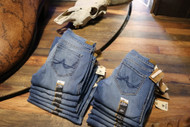Sizing Jeans for Kids
Apr 13th 2020
How to Find Jeans Sizes for Kids
Let's have some real talk. Our little ones grow and grow fast! The jeans we bought them two months ago may no longer fit them today. Maybe the jeans you just bought your little cowpoke are too small and you were double sure you ordered the right size. Kids are always growing, and clothing sizing charts can be a bit of a chore to wade through—some companies use different size names, charts, and figures. Hopefully, we'll be able to give you hard-working moms and dads a chance to sigh in relief with our guide to jean sizes for kids.
How to Get Kids’ Measurements for Jeans
You'll need a measuring tape to take measurements of your little one's waist, hips, and inseam. If you don't have a tailor's tape measure, you can use a string to measure, then hold it alongside any ruler or tape measure.
Measuring tip: International jeans sizes are different from each other—European kids' sizes, for instance, use centimeters. We'll stick with American children’s clothing sizes, which use inches. Some kids’ jeans sizes will include a T, which stands for toddler.
Time to Measure
Corral the kiddo! Have them stand up nice and straight and still for an accurate measurement. Measure and write down the result for the:
- Waist: Wrap the tape measure around the natural waistline near your child's belly button.
- Hips: Have your kid standing up with feet together and place the measuring tape at what you think is the fullest point of their hips.
- Inseam: Measure from the upper thigh on the inside to the feet straight on the ground.
Additionally, if they're too young to stand still, you can use a well-fitted pair of your little one's pants to complete this step, instead. Take their best-fitting pair of jeans and lay them with the creases as smoothed out as possible, then measure the waist and inseam.
Tips for Boys’ and Girls’ Jeans Sizes
Jeans for younger boys tend to be shorter than girls’ jeans for the same age range and size. As he grows, however, the length of his jeans will increase compared to girls’ jeans—this is because boys are often taller than girls, so their inseam reflects this difference.
According to US size charts, boys’ jeans generally start at size 4. A size 4 has a 22-inch waist and 16-inch inseam. Boys jean sizes increase—from 5, 6, 7, and so forth. Boys’ jeans stop at size 16, which has a 28-inch waist and 30-inch inseam.
Girls’ jeans tend to be longer than boys’ jeans, but as sizes increase, they are eventually shorter than boys’ jeans. Girls’ jeans start with size 4, or G4, which is about 22 inches at the waist with a 19-inch inseam. As she grows, your cowgirl’s jean sizes follow the same sizing method: G5, G6, etc. up until G14.
Clothing Sizes May Differ From Brand to Brand
While many countries have established a general standard size when it comes to classifying clothing styles of all ages, the U.S. doesn't have any hard-and-fast rules or standardization for clothing sizes. Clothing brands have a bit of leeway in defining what the measurements equal what sizes. If you have your kids' measurements written down, there should always be a size chart for you to compare and translate inches to sizes particular to that brand.
While you may not be able to rely on a standardized size, you can rely on certain brands of jeans being durable, long-lasting, rough, and tough while comfortable at the same. Brands such as Ariat for example, excel for active cowgirls and cowboys. Carhartt is known for its sturdy and precious toddler jeans, and Wrangler is a legend for both kids and adult jeans, one of the many reasons why they're our favorite.
Tips for Choosing Kids’ Jeans
- Once you've got your size, you may want to add an inch or two to the numbers you've jotted down for your kid's waist, hips and inseam. This isn't simply because they do grow so fast, but to accommodate any shrinkage in the wash that may happen too.
- When it comes to toddler-sized jeans, a good brand will include an adjustable waistband inside the jeans but as they grow older this is no longer included. For older kids, they may prefer to wear a belt to keep their pants in place.
- Regular jean sizes may differ from slim and plus size kids jeans. Look at each brand’s size chart to figure out how the measurements you've taken size up, and if you need to consider slim or plus-sized options.
- To avoid shrinkage or other issues, we recommend wearing jeans a few times between washes, if possible. But always check the label to follow care instructions.
- When determining kids' jeans sizes, factor in the brand as well. Not all kids' jeans brands match up, size-wise.
- Finding the right brand depends on how active your child is, too: If your child is extremely active, you'll want kids' jeans that take that into account with elastic or built-in stretch.
- Some brands use contrasting hems, varied stitches, and occasionally different textures in their denim as well. If your little cowboy or cowgirl doesn't like scratchy textures or prefers their jeans soft and stretchy, keep the differences in brand styles in mind when searching for the jeans for them.
Looking for more cowboy and Western wear resources? Sign up for our newsletter so you never miss a thing from Stages West and explore our blog for inspiration and the latest cowboy trends sweeping across the U.S.

